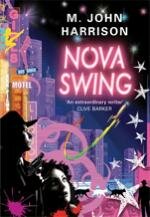

Nova Swing by M. John Harrison
Reviewed by Gary Dalkin
Gollancz, London, 2006, 240pp, £17.99, h/b (reviewed in proof), ISBN 0-575-07027-7
Nova Swing is described on the cover of my 'uncorrected manuscript proof' review copy as a sequel to M. John Harrison's Light (2003). It is so in the sense that it is set in the same future, a generation later with different characters. There is no direct continuation of the story from Light and the book can be read independently. Where Light involved heavy-weight quantum physics, space battles, a serial killer and a storyline set in the present to balance the future space opera, Nova Swing is a smaller scale work set entirely in one city on an alien planet in the year 2444AD.
Saudade is a port both on a beach and on the Beach, an insignificant refuelling point for interstellar ships. On the waters edge, down by the Surf Café is the aureole of an 'event site', a reality dysfunction where artefacts fall to ground from the Kefahuchi Tract. Here "drunks, junkies, sky-pilots and entradistas" can be found scooping artefacts "up of the ground in open contravention of common sense". It is a place where time is adrift, where "They weren't even sure if inside/outside concepts had meaning" and "No perspective, no data, no count of any kind could be depended upon".
If this brings to mind Boris & Arkady Strugatsky's novel Roadside Picnic, or Andrei Tarkovsky's film of the book, Stalker, it is meant to. M. John Harrison opens Nova Swing with a quote from the Strugatskys' novel: "The further into the Zone the nearer to Heaven".
As Harrison's The Centauri Device parodied space opera, so Nova Swing parodies the hard boiled detective novel. A second introductory quote offers the idea that "Nostalgia and science fiction are spookily close" (A. A. Gill in The Sunday Times). And this is a book filled with nostalgia, set-dressed with retro recreations of the past. With old forms of fiction, with old objects, old music. Detective Lens Aschemann is nostalgic for New Nuevo Tango. The band in the Surf Café play BeBop. The radio in Len's 1950's style Cadillac plays Radio Retro. So much of the novel transpires in a trio of drinking joints it might be called Three Bar Blues. Except Nova Swing isn't a form of music, but the name of the spaceship Irene the Mona dreams of buying to escape the planet and live her dreams.
And in Nova Swing everyone dreams of escape. Edith, once a famous dancer and accordion player considers everyone washed-up and looking to reclaim a life they'd lost by the time they were sixteen. Lens, who looks like Einstein, polices artefacts taken from the event site, and spends his time in regretful reverie over the unsolved murder of his wife. Lens' ambitious young female assistant escapes into a VR recreation of the repressed life of a 1950's American housewife. Emil spends his days sick in bed, proud of his achievements having destroyed his health. Vic Seratonin skirts the edge of the law while meeting the needs, sexual and otherwise of new client Mrs Elizabeth Kielar, who he has taken into the event site once and who is determined to return.
But something is changing. Club owner Paulie DeReed is undergoing a nightmare transformation after buying an artefact from Vic, and strange people are emerging from the event site, most of whom vanish within the hour, a few of whom survive.
All these various threads come gradually together in a narrative which is more a surreal puzzle wrapped in a sedate novel of character than either a space opera or the 'space noir' suggested by the marketing. There is in the sometimes sordid sometimes tender story a sense of bleak ennui, a middle-aged or elderly regret, of the passing of possibilities with the passage of time. This can be depressing, or a salutary wake-up call to the fact that life is not a rehearsal. It is a tone reminiscent of Stalker, though fortunately the book has rather more pace than the Tarkovsky film, and it is also entirely in keeping with M. John Harrison, from Viriconium onwards. When one character notes that it is not possible to know for certain if the place we come back to when we leave the event site is the same as the place we left when we went into the event site we know we are in a very British science fictional world. It is the dislocation found in many of J. G. Ballard's stories, or a novel such as Christopher Priest's A Dream of Wessex.
Nova Swing is a slowly paced, deliberate novel. Though it is well written it is not overtly literary. It does not necessarily proclaim its own significance. It is in places absurd, deliberately, knowingly, ironically so. Some of the character names, not least Vic Seratonin, are ridiculous. The black and white cats are a nice joke for anyone familiar with the UK sf world. It is a book which gradually gets under the skin, worms its way into the imagination and has a cumulative impact, such that I found myself thinking about it for days. It is not a likeable book, but it is an intriguing one which reserves surprises right to the final page. An unusual remake with its own strange rewards, self-aware, sour, and peculiarly romantic, Nova Swing is a true space oddity.
This article first appeared in Vector 252. Back issues of Vector are available from
